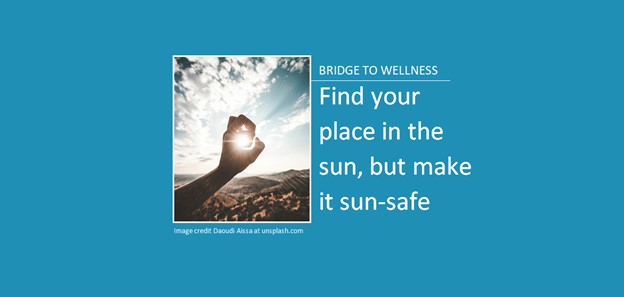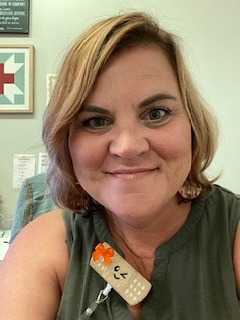
Bridge to Wellness
Find your place in the sun, but make it sun-safe
by Jennifer Matthews
The sun is back, and boy do we need it here in Michigan! Sun is so good for us—in moderation. However, it can also be bad for us if we don’t protect ourselves when necessary. Here are some important facts and tips to make sure you have a summer full of safe fun in the sun!
The benefits
Sunlight can have important benefits, like those listed here:
- Boosting vitamin D: This vitamin is crucial to the body and can positively affect bone and muscle health, blood pressure, immune function, brain function and blood sugar regulation.
- Killing bacteria: Studies have shown bacteria survive longer in a dark environment than an environment exposed to sunlight.
- Improving sleep quality: Sunlight plays a big role in our natural wake and sleep schedule, also known as circadian rhythm.
- Helping your mood. Many people suffer from seasonal depression during the months the sun isn’t out much. Getting plenty of sun can help keep serotonin levels in the brain where they need to be to boost your mood.
Safety recommendations
Many things in our world, while good for us, can also become dangerous if not used wisely. The sun is no different. Practicing safe sun exposure is one of the best ways to reduce your risk of sun-related cancers and illnesses. Following are some safety recommendations for sunlight exposure.
- Pay attention to the UV index. Too much UV light exposure can contribute to certain cancers. UV rays are the strongest from 10:00 am to 4:00 pm. Use sun protection when you are out for long periods of time during this time of day.
- Use sunscreen. A broad-spectrum sunscreen will have an SPF of 15 or higher. Don’t forget to reapply every couple of hours or after prolonged water exposure or sweating.
- Incorporate other sun protection: Besides using sunscreen or lotion, staying in shade when out for long periods can be helpful.
- Cover your skin. When you’re out for a long time, keep your skin covered with a t-shirt or beach cover up. Clothing from a tightly woven fabric is best.
- Wear a hat. A hat with a brim all the way around is best to protect your face, ears, and the back of your neck.
- Protect your eyes. Wearing sunglasses to protect your eyes from UV rays can reduce the risk of cataracts. The skin around your eyes is thin and sensitive and also benefits from the coverage provided by sunglasses.
Healing from sunburn
If you do find yourself or a loved one dealing with a sunburn, use these tips and tricks to help with the healing process.
- Cool off with water. Frequent cool baths or showers can relieve pain. Leaving a little water on the skin to air dry after will also feel good.
- Use a moisturizer containing aloe vera. Aloe is soothing to the skin and can help reduce pain and retain moisture.
- Use a pain reliever. Take an aspirin or ibuprofen. Both of these medications can help with redness, swelling, and discomfort. Follow their instructions for use.
- Drink lots of water! A sunburn draws fluid to the skin and away from other parts of the body. A sunburn can increase the risk of dehydration.
- Allow blisters to heal.If your skin blisters, do not pop them; they protect you from infection while the tissue underneath heals.
- Protect sunburned skin. Take extra care to protect already sunburned skin from the sun. Subsequent sunburns will make things much worse.
In my opinion, Michigan is the best place to enjoy a beautiful sunny summer. Staying informed can help us all to enjoy our summer safely. Happy Safe Sunning!

 This column is sponsored by the Stockbridge Area Wellness Coalition. Jennifer Matthews, RN, is a registered nurse in the Stockbridge School System. She has worked as a community nurse for the last eight years and is an active volunteer within the Jackson County foster care system. Jen has a passion for helping individuals advocate for their health and learn to navigate the healthcare system.
This column is sponsored by the Stockbridge Area Wellness Coalition. Jennifer Matthews, RN, is a registered nurse in the Stockbridge School System. She has worked as a community nurse for the last eight years and is an active volunteer within the Jackson County foster care system. Jen has a passion for helping individuals advocate for their health and learn to navigate the healthcare system.



